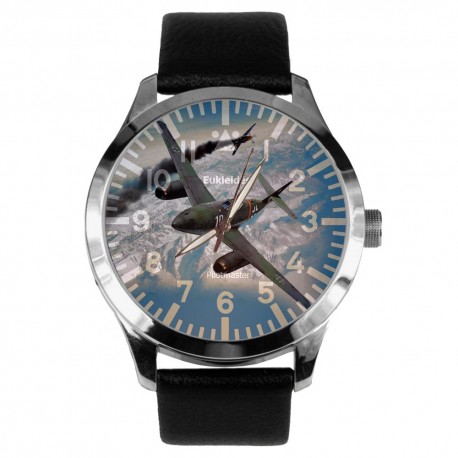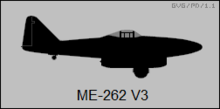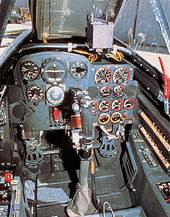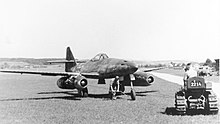No products
Me-262 Messerschmitt "Schwalbe" 1944 Luftwaffe WW-II Germany Dogfihht Art Collectible Watch
me262-03
New product
- Premium Citizen 2040 quartz movement.
- 40 mm large size heavy brass case.
- Rubberized Leather band.
- Unique Collectible Limited Edition Handmade Watches.
More info
The Messerschmitt Me 262, nicknamed Schwalbe (German: "Swallow") in fighter versions, or Sturmvogel (German: "Storm Bird") in fighter-bomber versions, was the world's first operational jet-powered fighter aircraft. Design work started before World War II began, but problems with engines, metallurgy and top-level interference kept the aircraft from operational status with the Luftwaffe until mid-1944. The Me 262 was faster and more heavily armed than any Allied fighter, including the British jet-powered Gloster Meteor.[5] One of the most advanced aviation designs in operational use during World War II,[6] the Me 262's roles included light bomber, reconnaissance and experimental night fighter versions.
Me 262 pilots claimed a total of 542 Allied aircraft shot down,[7] although higher claims are sometimes made.[Note 1] The Allies countered its effectiveness in the air by attacking the aircraft on the ground and during takeoff and landing. Strategic materials shortages and design compromises on the Junkers Jumo 004 axial-flow turbojet engines led to reliability problems. Attacks by Allied forces on fuel supplies during the deteriorating late-war situation also reduced the effectiveness of the aircraft as a fighting force. Armament production within Germany was focused on more easily manufactured aircraft.[9] In the end, the Me 262 had a negligible impact on the course of the war as a result of its late introduction and the consequently small numbers put in operational service.[10]
While German use of the aircraft ended with the close of World War II, a small number were operated by the Czechoslovak Air Force until 1951. It also heavily influenced several designs, such as Sukhoi Su-9 (1946) and Nakajima Kikka. Captured Me 262s were studied and flight tested by the major powers, and ultimately influenced the designs of post-war aircraft such as the North American F-86 Sabre, MiG-15 and Boeing B-47 Stratojet.[6] Several aircraft survive on static display in museums, and there are several privately built flying reproductions that use modern General Electric J85 engines.
Design and development
Origins
Several years before World War II, the Germans foresaw the great potential for aircraft that used the jet engine constructed by Hans Joachim Pabst von Ohain in 1936. After the successful test flights of the world's first jet aircraft—the Heinkel He 178—within a week of the Invasion of Poland to start the war, they adopted the jet engine for an advanced fighter aircraft. As a result, the Me 262 was already under development as Projekt 1065 (P.1065) before the start of World War II. The project originated with a request by the Reichsluftfahrtministerium (RLM, Ministry of Aviation) for a jet aircraft capable of one hour's endurance and a speed of at least 850 km/h (530 mph; 460 kn).[11] Dr Waldemar Voigt headed the design team, with Messerschmitt's chief of development, Robert Lusser, overseeing.[12]
Plans were first drawn up in April 1939, and the original design was very different from the aircraft that eventually entered service, with wing root-mounted engines,[12] rather than podded ones, when submitted in June 1939.[12] The progression of the original design was delayed greatly by technical issues involving the new jet engine. Because the engines were slow to arrive, Messerschmitt moved the engines from the wing roots to underwing pods, allowing them to be changed more readily if needed; this would turn out to be important, both for availability and maintenance.[13] Since the BMW 003 jets proved heavier than anticipated, the wing was swept slightly, by 18.5°, to accommodate a change in the center of gravity.[13] Funding for the jet engine program was also initially lacking as many high-ranking officials thought the war could easily be won with conventional aircraft.[14] Among those were Hermann Göring, head of the Luftwaffe, who cut the engine development program to just 35 engineers in February 1940 (the month before the first wooden mock-up was completed);[12] Willy Messerschmitt, who desired to maintain mass production of the piston-powered, 1935-origin Bf 109 and the projected Me 209; and Major General Adolf Galland, who had initially supported Messerschmitt through the early development years, flying the Me 262 himself on 22 April 1943. By that time, problems with engine development had slowed production of the aircraft considerably. One particularly acute problem arose with the lack of an alloy with a melting point high enough to endure the high temperatures involved, a problem that by the end of the war had not been adequately resolved.[14] The aircraft made its first successful flight entirely on jet power on 18 July 1942, powered by a pair of Jumo 004 engines, after a November 1941 flight (with BMW 003s) ended in a double flameout.[15]
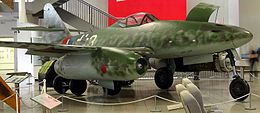
The project aerodynamicist on the design of the Me 262 was Ludwig Bölkow. He initially designed the wing using NACA airfoils modified with an elliptical nose section.[16] Later in the design process, these were changed to AVL derivatives of NACA airfoils, the NACA 00011-0.825-35 being used at the root and the NACA 00009-1.1-40 at the tip.[17] The elliptical nose derivatives of the NACA airfoils were used on the horizontal and vertical tail surfaces. Wings were of single-spar cantilever construction, with stressed skins, varying from 3 mm (0.12 in) skin thickness at the root to 1 mm (0.039 in) at the tip.[18] To expedite construction, save weight and use less strategic materials, late in the war, wing interiors were not painted.[19] The wings were fastened to the fuselage at four points, using a pair of 20 mm (0.79 in) and forty-two 8 mm (0.31 in) bolts.[19]
In mid-1943, Adolf Hitler envisioned the Me 262 as a ground-attack/bomber aircraft rather than a defensive interceptor. The configuration of a high-speed, light-payload Schnellbomber ("fast bomber") was intended to penetrate enemy airspace during the expected Allied invasion of France. His edict resulted in the development of (and concentration on) the Sturmvogel variant. It is debatable to what extent Hitler's interference extended the delay in bringing the Schwalbe into operation;[20][21] it appears engine vibration issues were at least as costly, if not more so.[15] Albert Speer, then Minister of Armaments and War Production, in his memoirs claimed Hitler originally had blocked mass production of the Me 262, before agreeing in early 1944. Hitler rejected arguments the aircraft would be more effective as a fighter against the Allied bombers destroying large parts of Germany, and wanted it as a bomber for revenge attacks. According to Speer, Hitler felt its superior speed compared to other fighters of the era meant it could not be attacked, and so preferred it for high altitude straight flying.[22]
The Me 262 is often referred to as a "swept wing" design as the production aircraft had a small, but significant leading edge sweep of 18.5° which likely provided an advantage by increasing the critical Mach number.[23] Sweep, uncommon at the time, was added after the initial design of the aircraft. The engines proved heavier than originally expected, and the sweep was added primarily to position the center of lift properly relative to the center of mass. (The original 35° sweep, proposed by Adolf Busemann, was not adopted.)[24] On 1 March 1940, instead of moving the wing backward on its mount, the outer wing was re-positioned slightly aft; the trailing edge of the midsection of the wing remained unswept.[25] Based on data from the AVA Göttingen and wind tunnel results, the inboard section's leading edge (between the nacelle and wing root) was later swept to the same angle as the outer panels, from the "V6" sixth prototype onward throughout volume production.[26]
Test flights
Test flights began on 18 April 1941, with the Me 262 V1 example, bearing its Stammkennzeichen radio code letters of PC+UA, but since its intended BMW 003 turbojets were not ready for fitting, a conventional Junkers Jumo 210 engine was mounted in the V1 prototype's nose, driving a propeller, to test the Me 262 V1 airframe.[27] When the BMW 003 engines were installed, the Jumo was retained for safety, which proved wise as both 003s failed during the first flight and the pilot had to land using the nose-mounted engine alone.[1] The V1 through V4 prototype airframes all possessed what would become an uncharacteristic feature for most later jet aircraft designs, a fully retracting conventional gear setup with a retracting tailwheel—indeed, the very first prospective German "jet fighter" airframe design ever flown, the Heinkel He 280, used a retractable tricycle landing gear from its beginnings, and flying on jet power alone as early as the end of March 1941.
The V3 third prototype airframe, with the code PC+UC, became a true jet when it flew on 18 July 1942 in Leipheim near Günzburg, Germany, piloted by test pilot Fritz Wendel.[28] This was almost nine months ahead of the British Gloster Meteor's first flight on 5 March 1943. Its retracting conventional tail wheel gear (similar to other contemporary piston powered propeller aircraft), a feature shared with the first four Me 262 V-series airframes, caused its jet exhaust to deflect off the runway, with the wing's turbulence negating the effects of the elevators, and the first takeoff attempt was cut short.[29]
On the second attempt, Wendel solved the problem by tapping the aircraft's brakes at takeoff speed, lifting the horizontal tail out of the wing's turbulence.[29] The aforementioned initial four prototypes (V1-V4) were built with the conventional gear configuration. Changing to a tricycle arrangement—a permanently fixed undercarriage on the fifth prototype (V5, code PC+UE), with the definitive fully retractable nosewheel gear on the V6 (with Stammkennzeichen code VI+AA, from a new code block) and subsequent aircraft corrected this problem.[Note 2]
Test flights continued over the next year, but engine problems continued to plague the project, the Jumo 004 being only marginally more reliable than the lower-thrust (7.83 kN/1,760 lbf) BMW 003. Airframe modifications were complete by 1942 but, hampered by the lack of engines, serial production did not begin until 1944, and deliveries were low, with 28 Me 262s in June, 59 in July, but only 20 in August.[31][page needed]
By Summer 1943, the Jumo 004A engine had passed several 100-hour tests, with a time between overhauls of 50 hours being achieved.[32] However, the Jumo 004A engine proved unsuitable for full-scale production because of its considerable weight and its high utilization of strategic material (Ni, Co, Mo), which were in short supply. Consequently, the 004B engine was designed to use a minimum amount of strategic materials. All high heat-resistant metal parts, including the combustion chamber, were changed to mild steel (SAE 1010) and were protected only against oxidation by aluminum coating. The total engine represented a design compromise to minimize the use of strategic materials and to simplify manufacture.[32] With the lower-quality steels used in the 004B, the engine required overhaul after just 25 hours for a metallurgical test on the turbine. If it passed the test, the engine was refitted for a further 10 hours of usage, but 35 hours marked the absolute limit for the turbine wheel.[33] While BMW's and Junkers' axial compressor turbojet engines were characterised by a sophisticated design that could offer considerable advantage – also used in a generalized form for the contemporary American Westinghouse J30 turbojet – the lack of rare materials for the Jumo 004 design put it at a disadvantage compared to the "partly axial-flow" Power Jets W.2/700 turbojet engine which, despite its own largely centrifugal compressor-influenced design, provided (between an operating overhaul interval of 60–65 hours[34]) an operational life span of 125 hours. Frank Whittle concludes in his final assessment over the two engines: "it was in the quality of high temperature materials that the difference between German and British engines was most marked"[35]
Operationally, carrying 2,000 litres (440 imperial gallons; 530 US gallons) of fuel in two 900-litre (200-imperial-gallon; 240-US-gallon) tanks, one each fore and aft of the cockpit; and a 200-litre (44-imperial-gallon; 53-US-gallon) ventral fuselage tank beneath,[Note 3] the Me 262 would have a total flight endurance of 60 to 90 minutes. Fuel was usually J2 (derived from brown coal), with the option of diesel or a mixture of oil and high octane B4 aviation petrol.[36] Fuel consumption was double the rate of typical twin-engine fighter aircraft of the era, which led to the installation of a low-fuel warning indicator in the cockpit that notified pilots when remaining fuel fell below 250 l (55 imp gal; 66 US gal).[36]
Unit cost for an Me 262 airframe, less engines, armament, and electronics, was RM87,400.[37][Note 4] To build one airframe took around 6,400 man-hours.[37]
Operational history

Introduction
On 19 April 1944, Erprobungskommando 262 was formed at Lechfeld just south of Augsburg, as a test unit (Jäger Erprobungskommando Thierfelder, commanded by Hauptmann Werner Thierfelder)[3][40] to introduce the 262 into service and train a corps of pilots to fly it. On 26 July 1944, Leutnant Alfred Schreiber with the 262 A-1a W.Nr. 130 017 damaged a Mosquito reconnaissance aircraft of No. 540 Squadron RAF PR Squadron, which was allegedly lost in a crash upon landing at an air base in Italy.[41] Other sources state the aircraft was damaged during evasive manoeuvres and escaped.[42]
Major Walter Nowotny was assigned as commander after the death of Thierfelder in July 1944, and the unit redesignated Kommando Nowotny. Essentially a trials and development unit, it mounted the world's first jet fighter operations. Trials continued slowly, with initial operational missions against the Allies in August 1944, and the unit made claims for 19 Allied aircraft in exchange of six Me 262s lost.[43]
Despite orders to stay grounded, Nowotny chose to fly a mission against an enemy bomber formation flying some 9,100 m (30,000 ft) above, on 8 November 1944. He claimed two P-51Ds destroyed before suffering engine failure at high altitude.[44] Then, while diving and trying to restart his engines, he was attacked by other Mustangs, forced to bail out, and died. The Kommando was then withdrawn for further flight training and a revision of combat tactics to optimise the 262's strengths.[citation needed]
On 26 November 1944, a Me 262A-2a Sturmvogel of III.Gruppe/KG 51 'Edelweiß' based at Rheine-Hopsten Air Base near Osnabrück was the first confirmed ground-to-air kill of a jet combat aircraft. The 262 was shot down by a Bofors gun of B.11 Detachment of 2875 Squadron RAF Regiment at the RAF forward airfield of Helmond, near Eindhoven. Others were lost to ground fire on 17 and 18 December when the same airfield was attacked at intervals by a total of 18 Me 262s and the guns of 2873 and 2875 Squadrons RAF Regiment damaged several, causing at least two to crash within a few miles of the airfield. In February 1945, a B.6 gun detachment of 2809 Squadron RAF Regiment shot down another Me 262 over the airfield of Volkel. The final appearance of 262s over Volkel was in 1945 when yet another fell to 2809's guns.[45]
By January 1945, Jagdgeschwader 7 (JG 7) had been formed as a pure jet fighter wing, partly based at Parchim[46] although it was several weeks before it was operational. In the meantime, a bomber unit—I Gruppe, Kampfgeschwader 54 (KG(J) 54)—redesignated as such on 1 October 1944[47] through being re-equipped with, and trained to use the Me 262A-2a fighter-bomber for use in a ground-attack role. However, the unit lost 12 jets in action in two weeks for minimal returns.[citation needed] Jagdverband 44 (JV 44) was another Me 262 fighter unit, of squadron (Staffel) size given the low numbers of available personnel, formed in February 1945 by Lieutenant General Adolf Galland, who had recently been dismissed as Inspector of Fighters. Galland was able to draw into the unit many of the most experienced and decorated Luftwaffe fighter pilots from other units grounded by lack of fuel.[48]
During March, Me 262 fighter units were able, for the first time, to mount large-scale attacks on Allied bomber formations. On 18 March 1945, thirty-seven Me 262s of JG 7 intercepted a force of 1,221 bombers and 632 escorting fighters. They shot down 12 bombers and one fighter for the loss of three Me 262s. Although a 4:1 ratio was exactly what the Luftwaffe would have needed to make an impact on the war, the absolute scale of their success was minor, as it represented only 1% of the attacking force.
In the last days of the war, Me 262s from JG 7 and other units were committed in ground assault missions, in an attempt to support German troops fighting Red Army forces. Just south of Berlin, halfway between Spremberg and the German capital, Wehrmacht's 9th Army (with elements from the 12 Army and 4th Panzer Army) was assaulting the Red Army's 1st Ukrainian Front. To support this attack, on 24 April, JG 7 dispatched thirty-one Me 262s on a strafing mission in the Cottbus-Bautzen area. Luftwaffe pilots claimed six lorries and seven Soviet aircraft, but three German jets were lost. On the evening of 27 April, thirty-six Me 262s from JG 7, III.KG(J)6 and KJ(J)54 were sent against Soviet forces that were attacking German troops in the forests north-east of Baruth. They succeeded in strafing 65 Soviet lorries, after which the Me 262s intercepted low flying IL-2 Sturmoviks searching for German tanks. The jet pilots claimed six Sturmoviks for the loss of three Messerschmitts. During operations between 28 April and 1 May Soviet fighters and ground fire downed at least ten more Me 262s from JG 7.[49] However, JG 7 managed to keep its jets operational until the end of the war. And on the 8th of May, at around 4:00 p.m. Oblt. Fritz Stehle of 2./JG 7, while flying a Me 262 on the Erzgebirge, attacked a formation of Soviet aircraft. He claimed a Yakovlev Yak-9, but the plane shot down was probably a P-39 Airacobra. Soviet records show that they lost two Airacobras, one of them probably downed by Stehle, who would thus have scored the last Luftwaffe air victory of the war.[50]
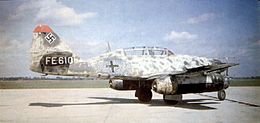
Several two-seat trainer variants of the Me 262, the Me 262 B-1a, had been adapted through the Umrüst-Bausatz 1 factory refit package as night fighters, complete with on-board FuG 218 Neptun high-VHF band radar, using Hirschgeweih ("stag's antlers") antennae with a set of dipole elements shorter than the Lichtenstein SN-2 had used, as the B-1a/U1 version. Serving with 10. Staffel Nachtjagdgeschwader 11, near Berlin, these few aircraft (alongside several single-seat examples) accounted for most of the 13 Mosquitoes lost over Berlin in the first three months of 1945.[51] Intercepts were generally or entirely made using Wilde Sau methods, rather than AI radar-controlled interception. As the two-seat trainer was largely unavailable, many pilots made their first jet flight in a single-seater without an instructor.[52]
Despite its deficiencies, the Me 262 clearly marked the beginning of the end of piston-engined aircraft as effective fighting machines. Once airborne, it could accelerate to speeds over 850 km/h (530 mph), about 150 km/h (93 mph) faster than any Allied fighter operational in the European Theater of Operations.[53]
The Me 262's top ace[Note 5] was probably Hauptmann Franz Schall with 17 kills, including six four-engine bombers and ten P-51 Mustang fighters, although fighter ace Oberleutnant Kurt Welter claimed 25 Mosquitos and two four-engine bombers shot down by night and two further Mosquitos by day. Most of Welter's claimed night kills were achieved by eye, even though Welter had tested a prototype Me 262 fitted with FuG 218 Neptun radar. Another candidate for top ace on the aircraft was Oberstleutnant Heinrich Bär, who is credited with 16 enemy aircraft[54] while flying Me262s out of his total of 240 aircraft shot down.[55]
Anti-bomber tactics

The Me 262 was so fast that German pilots needed new tactics to attack Allied bombers. In the head-on attack, the combined closing speed of about 320 m/s (720 mph) was too high for accurate shooting, with ordnance that could only fire about 44 shells a second (650 rounds/min from each cannon) in total from the quartet of them. Even from astern, the closing speed was too great to use the short-ranged quartet of MK 108 cannon to maximum effect. Therefore, a roller-coaster attack was devised. The 262s approached from astern and about 1,800 m higher (5,900 ft) than the bombers. From about five km behind (3.1 mi), they went into a shallow dive that took them through the escort fighters with little risk of interception. When they were about 1.5 km astern (0.93 mi) and 450 m (1,480 ft) below the bombers, they pulled up sharply to reduce speed. On levelling off, they were one km astern (1,100 yd) and overtaking the bombers at about 150 km/h (93 mph), well placed to attack them.[56]
Since the 30mm MK 108 cannon's short barrels and low muzzle velocity (only 540 m/s (1,900 km/h; 1,200 mph)) rendered it inaccurate beyond 600 m (660 yd; 2,000 ft), coupled with the jet's velocity, which required breaking off at 200 m (220 yd; 660 ft) to avoid colliding with the target, Me 262 pilots normally commenced firing at 500 m (550 yd; 1,600 ft).[57] Gunners of Allied bomber aircraft found their electrically powered gun turrets had problems tracking the jets. Target acquisition was difficult because the jets closed into firing range quickly and remained in firing position only briefly, using their standard attack profile, which proved more effective.[citation needed]
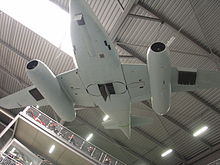
A prominent Royal Navy test pilot, Captain Eric Brown, chief naval test pilot and commanding officer of the Captured Enemy Aircraft Flight Royal Aircraft Establishment, who tested the Me 262 noted:
"This was a Blitzkrieg aircraft. You whack in at your bomber. It was never meant to be a dogfighter, it was meant to be a destroyer of bombers... The great problem with it was it did not have dive brakes. For example, if you want to fight and destroy a B-17, you come in on a dive. The 30mm cannon were not so accurate beyond 600 metres [660 yd; 2,000 ft]. So you normally came in at 600 yards [550 m; 1,800 ft] and would open fire on your B-17. And your closing speed was still high and since you had to break away at 200 metres [220 yd; 660 ft] to avoid a collision, you only had two seconds firing time. Now, in two seconds, you can't sight. You can fire randomly and hope for the best. If you want to sight and fire, you need to double that time to four seconds. And with dive brakes, you could have done that."[57]
Eventually, German pilots developed new combat tactics to counter Allied bombers' defences. Me 262s, equipped with up to 24 unguided folding-fin R4M rockets—12 in each of two underwing racks, outboard of the engine nacelle—approached from the side of a bomber formation, where their silhouettes were widest, and while still out of range of the bombers' machine guns, fired a salvo of rockets with strongly brisant Hexogen-filled warheads, exactly the same explosive in the shells fired by the Me 262A's quartet of MK 108 cannon. One or two of these rockets could down even the famously rugged Boeing B-17 Flying Fortress,[58] from the "metal-shattering" brisant effect of the fast-flying rocket's 520 g (18 oz) explosive warhead. The much more massive BR 21 large-calibre rockets, used from their tubular launchers in undernose locations for an Me 262A's use (one either side of the nosewheel well) were only as fast as the MK 108's shells.
Though this broadside-attack tactic was effective, it came too late to have a real effect on the war, and only small numbers of Me 262s were equipped with the rocket packs.[59] Most of those so equipped were Me 262A-1a models, members of Jagdgeschwader 7.[60] This method of attacking bombers became the standard, and mass deployment of Ruhrstahl X-4 guided missiles was cancelled. Some nicknamed this tactic the Luftwaffe's Wolf Pack, as the fighters often made runs in groups of two or three, fired their rockets, then returned to base. On 1 September 1944, USAAF General Carl Spaatz expressed the fear that if greater numbers of German jets appeared, they could inflict losses heavy enough to force cancellation of the Allied bombing offensive by daylight.[citation needed]
Counter-jet tactics

The Me 262 was difficult to counter because its high speed and rate of climb made it hard to intercept. However, as with other turbojet engines at the time, the Me 262's engines did not provide sufficient thrust at low air speeds and throttle response was slow, so that in certain circumstances such as takeoff and landing the aircraft became a vulnerable target. Another disadvantage that pioneering jet aircraft of the World War II era shared, was the high risk of compressor stall and if throttle movements were too rapid, the engine(s) could suffer a flameout. The coarse opening of the throttle would cause fuel surging and lead to excessive jet pipe temperatures. Pilots were instructed to operate the throttle gently and avoid quick changes. German engineers introduced an automatic throttle regulator later in the war but it only partly alleviated the problem.
The plane had, by contemporary standards, a high wing loading (294.0 kg/m2, 60.2 lbs/ft2) that required higher takeoff and landing speeds. Due to poor throttle response, the engines' tendency for airflow disruption that could cause the compressor to stall was ubiquitous. The high speed of the Me 262 also presented problems when engaging enemy aircraft, the high-speed convergence allowing Me 262 pilots little time to line up their targets or acquire the appropriate amount of deflection. This problem faces any aircraft that approaches another from behind at much higher speed, as the slower aircraft in front can always pull a tighter turn, forcing the faster aircraft to overshoot.
Johannes Steinhoff, Luftwaffe fighter ace.[62]
Luftwaffe pilots eventually learned how to handle the Me 262's higher speed and the Me 262 soon proved a formidable air superiority fighter, with pilots such as Franz Schall managing to shoot down seventeen enemy fighters in the Me 262, ten of them American P-51 Mustangs. Other notable Me 262 aces included Georg-Peter Eder, with twelve enemy fighters to his credit (including nine P-51s), Erich Rudorffer also with twelve enemy fighters to his credit, Walther Dahl with eleven (including three Lavochkin La-7s and six P-51s) and Heinz-Helmut Baudach with six (including one Spitfire and two P-51s) amongst many others.[citation needed]
Pilots soon learned that the Me 262 was quite maneuverable despite its high wing loading and lack of low-speed thrust, especially if attention was drawn to its effective maneuvering speeds. The controls were light and effective right up to the maximum permissible speed and perfectly harmonised. The inclusion of full span automatic leading-edge slats,[Note 6] something of a "tradition" on Messerschmitt fighters dating back to the original Bf 109's outer wing slots of a similar type, helped increase the overall lift produced by the wing by as much as 35% in tight turns or at low speeds, greatly improving the aircraft's turn performance as well as its landing and takeoff characteristics.[65] As many pilots soon found out, the Me 262's clean design also meant that it, like all jets, held its speed in tight turns much better than conventional propeller-driven fighters, which was a great potential advantage in a dogfight as it meant better energy retention in maneuvers.[66][67]

Too fast to catch for the escorting Allied fighters, the Me 262s were almost impossible to head off. [Note 7] As a result, Me 262 pilots were relatively safe from the Allied fighters, as long as they did not allow themselves to get drawn into low-speed turning contests and saved their maneuvering for higher speeds. Combating the Allied fighters could be effectively done the same way as the U.S. fighters fought the more nimble, but slower, Japanese fighters in the Pacific.<sup&

